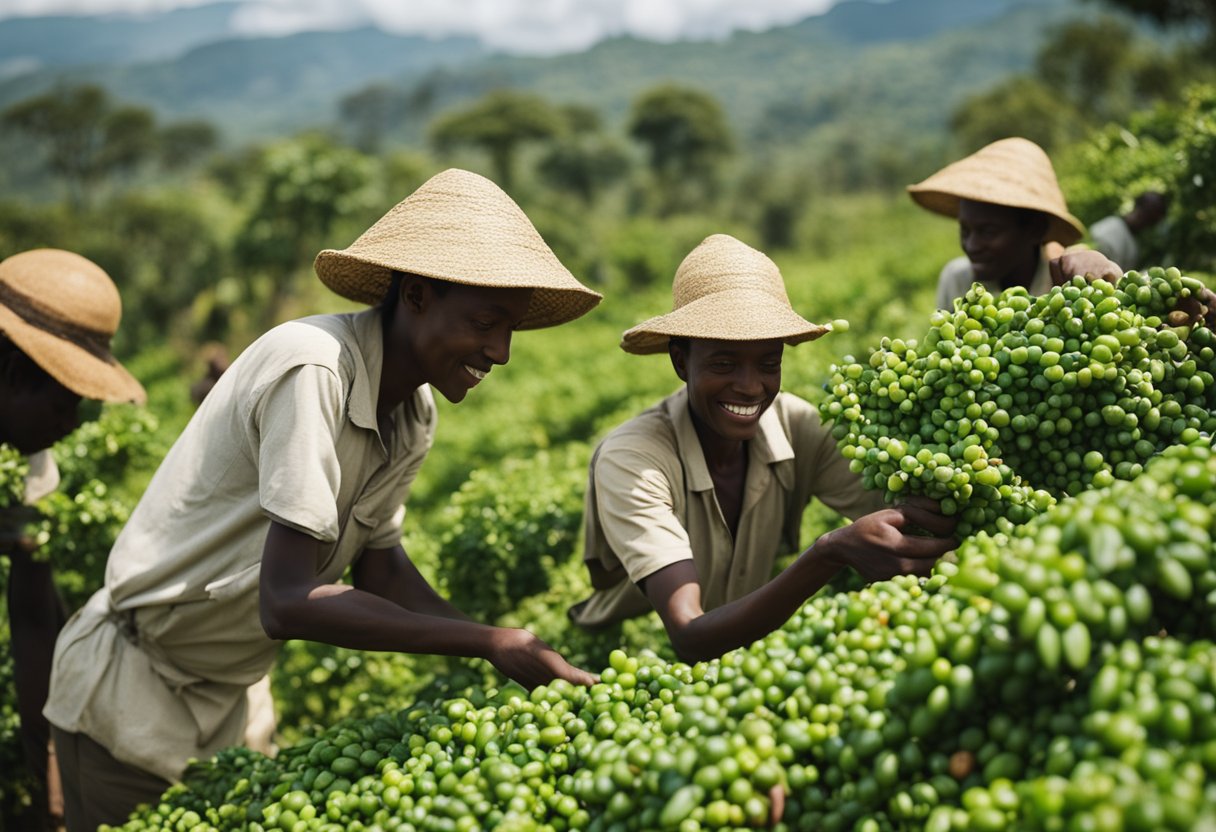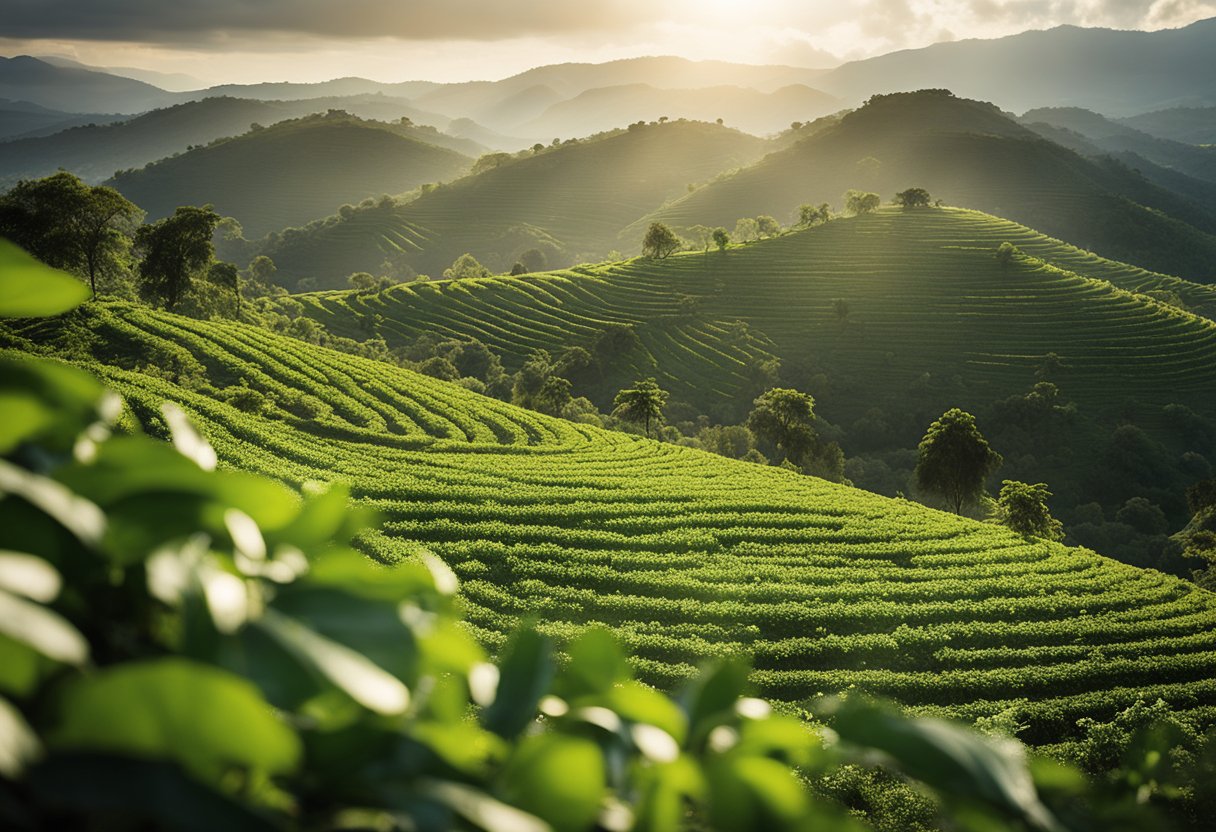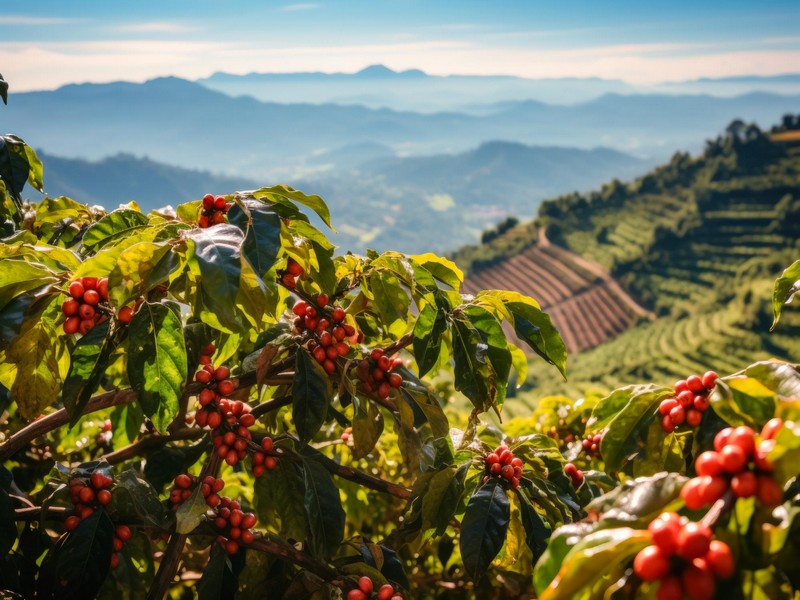Ethiopian Coffee: Tracing the Origins of Our Cherished Brew

Updated On: March 27, 2024 by Aya Radwan
Ethiopia proudly stands as a symbolic region for coffee connoisseurs around the globe, marking the very cradle where the celebrated Coffea Arabica first flourished. Tracing back to an ancient lineage, the hills and forests of this venerable land whisper tales of Kaldi, the young goat herder who, as legend has it, discovered the energising effects of the coffee cherries. These fertile landscapes provide far more than just scenic beauty; they are the nurturing grounds for some of the most sought-after coffee in the world, deeply woven into the fabric of Ethiopian culture and society.
The meticulous care in growing conditions and cultivation reflects in the distinct qualities of Ethiopian coffee, making each bean a relic of its unique terroir. Coffee farming communities across Ethiopia engage in time-honoured harvesting and processing methods, yielding beans that are not merely agricultural products but artisanal masterpieces. The traditional coffee ceremonies further exhibit the rich heritage, where brewing and partaking in coffee transcend into a communal experience rich with symbolism and a slow appreciation for the brew’s robust aroma and complex taste.
Origins of Coffee in Ethiopia
Ethiopia is renowned as the birthplace of coffee, a distinction steeped in rich history and compelling legends that resonate with coffee enthusiasts worldwide.
The Legend of Kaldi
The story of coffee begins with an alluring legend. A young Ethiopian goat herder named Kaldi observed his goats displaying unusual energy levels after consuming the red cherries of a certain bush. Curious, Kaldi tried these cherries himself and experienced a similar stimulating effect. This discovery is believed to have occurred as long ago as the ninth century, sparking a tradition that would echo through the ages. The tale of Kaldi has endured as a cultural touchstone in the history of coffee.
Ethiopian Coffee Culture
Coffee’s history is inextricably linked with Ethiopian culture. The ceremonial preparation and consumption of coffee, or ‘buna’, is deeply ingrained in the social fabric of Ethiopian society. Coffee is ceremoniously brewed and served in a tradition that underscores community and hospitality. This aspect of Ethiopian culture highlights a love for coffee and reveres its importance in social cohesion. Over centuries, the rituals surrounding coffee have been honed, ultimately contributing to what many now refer to as Ethiopian coffee culture.
In these early chapters of the beverage’s history, Ethiopia provided the foundation upon which the global appreciation of coffee would grow, intertwining the bean’s destiny with the Arabic world and beyond. As we delve into the origins of coffee within this majestic East African nation, we’re reminded of our collective journey with this beloved bean.
Ethiopian Coffee Varieties
Ethiopia, often revered as the cradle of the coffee bean, boasts an extensive array of coffee varieties, each with distinct characteristics and flavours. We encounter a diverse genetic lineup of coffee, particularly within the Arabica species, which flourishes across Ethiopia’s varied landscapes.
Arabica and Its Subspecies
Arabica (Coffea arabica) is Ethiopia’s most revered coffee-grown coffee species, known for its superior quality and complex flavour. It originates from numerous subspecies, each adapted to the unique microclimates of the Ethiopian highlands. Within Arabica, however, a notable subspecies is Typica, which is highly regarded and forms the genetic base for many other coffee varietals.
| Subspecies | Characteristics |
|---|---|
| Arabica | Sweet, complex, and aromatic |
| Typica | Traditional profile with exceptional taste |
Notable Regional Varietals
Ethiopia’s diverse terroirs have given rise to several prominent regional varietals. Each regional variety embodies the essence of its native landscape, offering a sip of the area’s spirit in every cup.
- Yirgacheffe: This highly coveted varietal is grown in southern Ethiopia. Yirgacheffe coffees are esteemed for their bright acidity, light to medium body, and distinct floral and citrus notes.
- Sidamo: Coveted for its rich, full body and sweet, complex taste, Sidamo features a smooth mouthfeel with flavours including berries and wine.
- Harar: Traditionally dry-processed, Harar beans are bold and express a strong presence with fruity, wine-like characteristics and a sharp acidity.
Each distinct Ethiopian varietal offers a unique window into the country’s rich coffee culture and history, allowing us to cherish the bean’s journey from its birthplace.
Growing Conditions and Cultivation

We are interested in the specific conditions and methods employed in Ethiopian coffee farms, which are vital for nurturing the world-famous Arabica bean.
Soil and Climate
Ethiopia’s rich, fertile soil, coupled with its favourable climate, lays the groundwork for coffee cultivation. The forest landscapes where these farms exist often possess a mixture of volcanic soil densely packed with essential nutrients. Ethiopian coffee benefits from a diverse climate range influenced by the country’s varied topography. Understanding the role of soil and climatic conditions, which include adequate rainfall and optimum temperature ranges, is paramount to comprehending the cultivation process of the region.
Altitude and Its Effects
The elevations at which Ethiopian coffee is grown are generally high, creating a distinct impact on the bean’s development. Arabica coffee typically thrives at elevations between 1,300 and 2,200 metres, with such high altitudes contributing towards slower bean maturation and, thus, a more complex flavour profile. Additionally, biodiversity is enriched by these altitudes, promoting a natural growing environment that supports the overall coffee ecosystem. The synergy between these factors allows the Ethiopian coffee bean to flourish, attesting to the region’s reputation as the birthplace of coffee.
Harvesting and Processing Methods
Ethiopia’s approach to coffee farming is as unique as the beans it yields. Key to this process is traditional methods of harvesting and processing, which are cornerstones in producing the country’s distinctive flavorful coffee.
Harvesting Techniques
In Ethiopia, we favour the selective handpicking of coffee cherries to ensure that only the ripest berries are processed. This labour-intensive technique allows for maximum yield and quality control. Farmers traverse their land, painstakingly harvesting the cherries that have reached a deep, ruby red—a sign of peak ripeness. Environmental factors, like altitude and rainfall, greatly influence the timing and yield of the harvesting season, which can vary from region to region within the country.
From Cherry to Green Bean
Once harvested, our cherries are processed primarily using the dry method. This ancient technique is environmentally friendly, as it requires no additional water. Freshly picked cherries lie in the sun for weeks, undergoing natural drying to evaporate moisture. Still, inside the dried husks, the beans are stored until the husks are removed, revealing the dry-processed bean’s intense fruity flavour. This dry-processed bean embodies Ethiopian coffee’s iconic profile and is revered by coffee lovers worldwide.
Traditional Ethiopian Coffee Ceremonies
The Ethiopian coffee ceremony is fundamental to our cultural fabric, embodying hospitality and community. As we participate in these ceremonies, we are reminded of the rich traditions passed down through generations.
The Ceremony: At the heart of this cultural experience is the Jebena, a traditional clay coffee pot in which the coffee is brewed. The process begins with washing green coffee beans, which are then roasted in a pan. The rich aroma of freshly roasted coffee fills the air, signalling the start of the ceremony.
Participants gather as the host—typically a woman—meticulously grinds the beans using a mortar and pestle. The grounds are then placed into the Jebena and set over a fire. As we wait, anticipation builds; coffee ceremonies are not rushed but a time to relax and connect.
Culture and Community: The coffee is served in small cups, and the ceremony typically includes three rounds of service: Abol, Tona, and Bereka. Each round has a meaning, with the first symbolising the initial pleasure of tasting the coffee, the second the conversation that ensues, and the third a blessing to those who drink it. It’s an opportunity to foster community discussions and uphold the social fabric of our society.
Ethiopian Culture: Coffee ceremonies in Ethiopia go beyond the drink itself; they are an art form, a communal activity, and a symbol of friendship and respect. Through these rituals, the essence of Ethiopian culture is shared, as is the story of the beloved bean that originated from our lands.
We invite you to consider the significance of these ceremonies to Ethiopian culture, offering an intimate glimpse into our people’s social and cultural life.
The Coffee Economy in Ethiopia

Coffee is integral to Ethiopia’s economy, providing a significant source of foreign exchange and supporting millions of livelihoods.
Export Markets
Ethiopian coffee has secured a crucial place globally, as the nation originates Coffea arabica. Coffee is vital to Ethiopia’s export sector, journeying to international markets enriching global coffee variety. The application of sustainable tree stumping techniques by Ethiopian farmers has led to increased production, allowing Ethiopia to meet the demands of the expansive export markets.
Contribution to GDP
Within Ethiopia’s economy, coffee plays a transformative role. Our research indicates that coffee contributes to approximately 24% of Ethiopia’s export income, highlighting its contribution to the Gross Domestic Product (GDP). Coffee cultivation is more than an economic activity; it’s a lifeline that sustains the existence of around 15 million Ethiopians, tying their welfare to the ebbs and flows of the global coffee market and initiatives like Fair Trade.
Environmental and Social Impacts
In the lush highlands of Ethiopia, coffee farming intertwines with the fabric of the local environment and society. Understanding the environmental and social impacts in this cradle of coffee cultivation reveals a delicate balance of climate adaptability and economic vitality.
Climate Change Repercussions
Climate change presents significant challenges to Ethiopian coffee farming, an industry pivotal for the nation’s economy and the livelihoods of its people. Shifts in weather patterns affect the suitability of areas for growing coffee, with temperature and rainfall negatively impacting yields. Such changes could severely affect areas currently known for their speciality coffee potential. The farmers face the daunting task of adapting to these climatic changes to safeguard not only their income but also the unique qualities of Ethiopian coffee.
Economic Empowerment and Challenges
Coffee farming is a crucial economic activity in Ethiopia, providing employment and livelihoods for millions. The industry creates opportunities for economic empowerment in regions like Sidamo, where traditional growing techniques are passed through generations. Sustainable practices, such as the use of tree stumping, aid in tripling yields and boosting income. However, the farmers’ continued prosperity is hindered by a lack of access to modern techniques and resources, which are challenges that must be faced to ensure the sustainability and growth of Ethiopia’s revered coffee legacy.
Innovations in Ethiopian Coffee Farming
In Ethiopia, home to the revered Arabica bean, coffee farmers are embracing new agricultural techniques and sustainability measures to bolster productivity and ensure the longevity of their livelihoods.
Modernisation Efforts
We’re witnessing significant modernisation efforts in Ethiopia’s coffee farms, with investment flowing towards improved infrastructure and contemporary farming methods. Innovations like drip irrigation systems enhance water usage efficiency, essential in arid regions. Initiatives are in place to replace outdated equipment with more modern tools to increase coffee beans’ productivity and quality.
- Training and Education: Farmers are receiving training on modern agricultural techniques.
- Quality Improvement: Upgraded equipment is used to ensure consistent bean quality.
- Infrastructure Investments: Investments in processing facilities and transportation are improving the supply chain.
Farmers in Ethiopia are also adopting new practices to enhance their agricultural output, ensuring that traditional coffee farming can thrive amidst changing global demands.
Sustainable Practices
Our focus on sustainable practices protects Ethiopia’s unique coffee forests, the genetic pool for Arabica coffee. Embracing sustainable tree stumping has multiplied yields, proving that eco-friendly approaches coexist with increased farm productivity.
- Climate Adaptation: Adapting farming practices to better cope with the changing climate.
- Conservation: Protecting coffee forest biodiversity through sustainable land use.
Through these methods, the environment is preserved, and the coffee farms become more resilient and able to weather the challenges posed by climate change. This is a testament to the sustainable transformation of Ethiopia’s coffee culture.
The Role of Coffee in Ethiopian Society
In Ethiopia, coffee isn’t just a drink; it’s a cornerstone of culture and a symbol of hospitality. Ethiopian coffee is believed to be traced back to the ninth century, and today, the country is celebrated as the birthplace of Arabica coffee.
Ceremony plays a pivotal role in Ethiopian coffee culture. The Ethiopian coffee ceremony, often led by a woman, is an elaborate process that can take up to two hours. It starts with roasting green coffee beans over an open flame, followed by grinding and brewing. During this time, guests may be invited to participate or observe as a sign of respect and community.
| Coffee Stage | Description |
|---|---|
| Washing | Beans are cleansed with water |
| Roasting | Beans are roasted in a pan over an open flame |
| Grinding | Roasted beans are ground by hand |
| Brewing | Ground coffee is brewed in a clay pot |
In Ethiopian culture, coffee is also associated with socialisation and discussion, often accompanying vibrant conversations. It’s customary to share coffee with family, friends, or visitors as a gesture of friendship or a way to resolve issues. The consumption of coffee also plays a significant role during religious holidays amongst the Muslim community and other faiths, maintaining its strong cultural significance.
Moreover, coffee is a vital component of the economy, supporting millions of households, predominantly through small-scale farming. This crop is not just economically critical but is entrenched deeply within the Ethiopian culture, with each cup shared becoming a narrative of its rich heritage.
Global Influence and Relationships
Ethiopia holds a prestigious position as the birthplace of the beloved coffee bean, shaping not only the global coffee culture but also forming intrinsic parts of international coffee agreements and commanding a unique place in the market.
International Coffee Agreements
International coffee agreements have stabilised global coffee prices and trade terms. As a leading coffee exporter, Ethiopia plays a vital role within these frameworks, ensuring that agreements benefit its farming sectors and the wider economy. Maintaining harmony in trade with countries such as the USA, Germany, Japan, and Saudi Arabia is essential for sector growth and favourable market access.
Ethiopia’s Position in the Market
Coffee from Ethiopia, renowned for its quality and the unique profiles of beans from regions like Sidamo, has cemented a strong position in the global market. Ethiopian coffee is highly sought after, with the USA and Germany being significant importers, while intrepid export chains connect to Japan, Saudi Arabia, and beyond. Our approach to sector sustainability and cultivating relationships with international markets remain crucial to our standing as a central player in the global coffee narrative.
Appreciating Ethiopian Coffees
When we think of Ethiopian coffee, we envision a tapestry of complex flavours that capture the essence of the bean’s profound history. From the wild forests where Arabica coffee has its origins, Ethiopian coffees bring a unique cupping profile celebrated all over the world.
Cupping Profiles
Ethiopian coffees offer a diverse range of cupping notes. Typically, we find various flavours, from vibrant citrus notes to delicate floral qualities and piquant spices. The soil, elevation, and processing methods imbue each bean with its distinctive characteristics. Intriguingly, the famed Yirgacheffe region, known for its washed coffees, often presents citrus and floral tones. In contrast, beans from the Harrar region can have a more spice-laden profile with subtler citrus elements.
Preparing and Enjoying at Home
Brewing techniques play a critical role in embracing the ritual of coffee at home. Many prefer methods like the French Press or AeroPress for a bold extraction that honours the roasted character of Ethiopian beans. However, for those who fancy a quick yet rich experience, modern innovations like Nespresso pods offer a practical alternative, featuring single-origin Ethiopian espresso capsules.
When brewing Ethiopian coffee, we also explore pour-over techniques to accentuate its delicate flavours. This method allows the subtle floral and citrus notes to shine, making each sip a testament to the bean’s origin. Using a V60 or a Chemex can produce a cleaner, more nuanced cup, providing a profound appreciation of the coffee’s intricate cupping notes.
By understanding the cupping profiles of Ethiopian beans and the nuances of different brewing techniques, we can enhance our enjoyment and appreciation of these extraordinary coffees right in the comfort of our homes.
Frequently Asked Questions

In this section, we address some of the most common inquiries about Ethiopia’s role as the origin of coffee and its continued significance in today’s global coffee landscape.
How did the cultivation of coffee begin in Ethiopia?
It is believed that coffee cultivation in Ethiopia dates back to the 9th century, originating from the discovery of the coffee plant’s stimulating effects by a goat herder named Kaldi. After this discovery, coffee became integral to Ethiopian culture and economy. The history of coffee in Ethiopia dates back centuries, deeply entwined with its people and traditions.
What unique characteristics does Ethiopian coffee possess?
Ethiopian coffee is renowned for its wide variety of flavours, often exhibiting floral, fruity, and wine-like notes, with some varieties presenting hints of chocolate or spice. The diversity in flavour is attributed to the country’s varying climates and landscapes, where each region’s unique terroir contributes to the distinct qualities of its coffee beans.
Which regions in Ethiopia are renowned for coffee production?
Several regions within Ethiopia are known for producing high-quality coffee, including Sidamo, Yirgacheffe, and Harrar. Each region has distinct geographical features, such as high altitude and rich, fertile soils conducive to cultivating coffee with unique flavour profiles.
How did Ethiopian coffee culture influence global coffee consumption?
With its traditional ‘coffee ceremony,’ Ethiopian coffee culture has contributed to the global appreciation of coffee as an experience rather than just a commodity. The ceremony is integral to social life and hospitality in Ethiopia, highlighting coffee’s role in fostering community. This cultural approach has influenced coffee cultures worldwide regarding how coffee is enjoyed and appreciated in social gatherings.
What historical events led to the spread of coffee from Ethiopia to Europe?
Trade routes through the Middle East and North Africa played a crucial role in the spread of coffee from Ethiopia to Europe in the 17th century. The popularity of coffee houses in cities like Istanbul helped introduce the beverage to European travellers, furthering its spread to European countries, where it soon became a staple.
In what ways did the Columbian Exchange affect the distribution of coffee?
The Columbian Exchange, which refers to the widespread transfer of plants, animals, culture, and technology between the Americas, West Africa, and the Old World, extended the reach of coffee cultivation. With the discovery and colonisation of new lands suitable for coffee growing, particularly in Latin America, the production and distribution of coffee on a global scale were greatly influenced and expanded.






